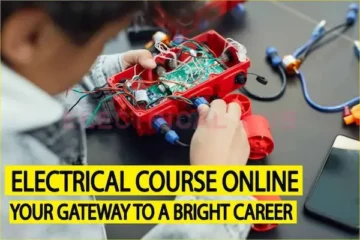Circuits & Electronics: Basic Analysis (free audit)
Learn circuit analysis with MITx on edX. Take the course for free, at your own pace.
Anúncios
And develop skills ready for the US job market.
Why this course is the best free starting point for electrical beginners in the USA
If you are just starting out and want a trustworthy path into electrical engineering, Circuits & Electronics: Basic Circuit Analysis” from MITx is a safe and smart choice.
You study core principles like voltage, current, resistance, and power in a structured sequence that helps beginners build confidence step by step.
Because the course offers an audit track, you can learn for free, explore the content at your own pace, and only consider paying later if you decide a certificate fits your goals.
That balance between rigor, clarity, and flexibility is exactly what new learners in the USA need when testing the waters before committing to longer programs.
The end result is a solid foundation in circuit thinking that transfers directly to hobby projects, future college courses, and entry-level technical paths.
Who this course serves and why it works
This path is ideal if you are a high-school graduate, a community-college student, a career-changer, or a self-taught maker who wants to learn analysis before touching hardware.
You will benefit if you prefer learning that is organized and progressive rather than a random playlist that skips essential steps.
You do not need prior lab access to follow the logic and math, which makes it accessible even if you are learning from home on a tight budget.
If you already tinkered with Arduino or Raspberry Pi but felt uncertain when circuits became complex, this course gives you the missing analysis tools.
What you will actually learn inside Circuits & Electronics
You will practice writing equations that describe how circuits behave, turning messy schematics into solvable problems you can reason about.
You will use Kirchhoff’s Laws, nodal analysis, and equivalent circuits to predict voltages, currents, and power across components with clarity.
You will explore linearity and superposition so you can break multi-source circuits into simpler parts and rebuild the answer with confidence.
You will meet real components like diodes and transistors at an introductory level, connecting ideal abstractions to practical behaviors.
By the end, you will recognize patterns, select the right method for each situation, and check your answers against physical intuition.

Free online electrical course beginner USA — how the audit option helps you start
The audit track lets you access the learning materials without cost, which lowers the barrier for anyone beginning their journey.
You can watch lessons, read explanations, and practice with exercises at your own pace, which is ideal if you have work, school, or family commitments.
If you later decide you want a verified certificate for a résumé or LinkedIn, you can upgrade when it makes sense for you and your budget.
This approach means you can start learning today without financial pressure while still keeping a credential option open for the future.
How to enroll in minutes
Open the official course page and click “Enroll,” then choose the free “Audit” option to begin learning without paying.
Create a free account or sign in so your progress is saved, which makes it easy to pause and resume on your own schedule.
Bookmark the course dashboard and set two or three weekly study blocks on your calendar to build a consistent learning habit.
Return to the same place each week and follow the sequence of lessons and practice activities, so every new idea reinforces the last one.
What to expect week by week
Expect a predictable rhythm that starts with short concept videos followed by guided practice, so ideas move from theory to application.
Expect math that is approachable with basic algebra and a bit of comfort with variables, equations, and units, even if you have been out of school for a while.
Expect repeatable methods that reduce anxiety, because you will learn to pick a systematic approach instead of guessing.
Expect practical insight that connects analysis to real components and everyday electronics, which keeps motivation high.
Tools and resources you can use for free
Use a simple scientific calculator to keep track of signs, reference nodes, and Ohm’s Law without getting lost in arithmetic.
Sketch circuits on paper to separate the physical schematic from the simplified analysis model, which makes complex problems more manageable.
When suggested, use free circuit simulators to test your intuition and sanity-check results before you ever touch hardware.
Keep a notebook of common identities, unit prefixes, and typical component values so your brain can focus on reasoning rather than remembering constants.
Free online electrical course beginner USA — the skills you will build
You will learn to translate a circuit diagram into equations and back again, which is the core engineering habit that unlocks design.
You will evaluate whether a result makes physical sense, comparing magnitudes and directions to your mental model of the circuit.
You will identify when to choose nodal analysis, when to build a Thevenin or Norton equivalent, and when to apply superposition, which saves time and confusion.
You will connect ideal math to practical decisions, like recognizing when a model breaks down because a device is saturating or a small-signal assumption no longer holds.
How this course compares to random playlists or unstructured tutorials
Random videos often skip steps, which forces beginners to memorize rather than understand, and that leads to frustration later.
An organized course introduces concepts in a logical sequence and revisits them with practice, which is exactly what new learners need.
You will be guided from simple circuits toward modest complexity without sudden jumps that leave gaps and erode confidence.
Because the structure is stable, you can reliably plan your study and measure progress rather than chasing scattered content.
Study plan for busy beginners in the USA
Plan two to three sessions per week of about one to two hours each, which adds up to a sustainable pace for most adults.
Front-load your first week if circuits are brand new so you internalize the basic laws and conventions early.
If you miss a session, do not try to binge a marathon the next day, because spaced practice is more effective than cramming.
End each study block by writing a three-line summary of what you learned, a common mistake you noticed, and one open question to revisit.
Free online electrical course beginner USA — common beginner pitfalls and how to avoid them
Always define reference directions for currents and assume polarities for voltages before writing equations, so you do not double count or flip signs accidentally.
Use the passive sign convention consistently so your power calculations are meaningful and you can tell sources from loads.
Check units at every major step, because a wrong prefix or mixed unit can hide an otherwise perfect solution.
If a result looks suspicious, try an alternate method like mesh versus nodal or test limiting cases to see if the behavior matches your intuition.
Step-by-step: your first problem-solving workflow
Start by redrawing the circuit cleanly and labeling every node and element with assumed directions and polarities.
Decide whether nodal, mesh, or a source transformation will be most efficient, and commit to one path before you begin.
Write equations carefully and group unknowns so you can solve them in a tidy system without losing track of variables.
Sanity-check your answers by verifying conservation of power, testing extreme values, and comparing magnitudes to typical component behavior.
How this course supports future learning and careers
With analysis fundamentals in place, you will be ready to approach op-amps, filters, and signal processing without feeling overwhelmed.
If you move into embedded systems, you will understand how analog front ends condition signals before microcontrollers read them.
If you pursue a degree later, you will recognize concepts immediately and spend your energy going deeper rather than catching up.
Even if you stay in the maker space, you will design cleaner circuits, troubleshoot faster, and read datasheets with much more confidence.
Transparency notice
This article is purely informativo e educativo, baseado em fontes públicas e em boas práticas de ensino de engenharia, e não possui vínculo, parceria, patrocínio ou controle sobre o MIT, MITx ou a plataforma edX.
Detalhes como datas, disponibilidade, trilhas de certificação, preços e políticas podem mudar a qualquer momento diretamente nas plataformas oficiais sem aviso prévio.
Recomendamos verificar sempre as informações mais recentes na página oficial do curso antes de se inscrever, fazer upgrade ou tomar qualquer decisão.
Free online electrical course beginner USA — final take and next steps
If you want a no-cost, beginner-friendly, and respected entry point into circuit analysis in the USA, this course offers exactly that.
Start in audit mode to remove financial pressure while you build momentum and evaluate whether the structure works for you.
Commit to a steady weekly rhythm, keep a tidy notebook, and focus on method selection and sanity checks as your two meta-skills.
When you feel ready for more depth or a credential, upgrade to the verified track or continue into follow-on courses with greater confidence.





